UNIVERSITY OF ALASKA ANCHORAGE
UNIVERSITY OF ALASKA ANCHORAGE
UNIVERSITY OF ALASKA ANCHORAGE
Create successful ePaper yourself
Turn your PDF publications into a flip-book with our unique Google optimized e-Paper software.
accolades<br />
Spring 2006<br />
<strong>UNIVERSITY</strong> <strong>OF</strong> <strong>ALASKA</strong> <strong>ANCHORAGE</strong><br />
RECIPE FOR SUCCESS<br />
UAA CULINARY ARTS<br />
AND HOSPITALITY
F R O M T H E C H A N C E L L O R<br />
accolades<br />
Ford Foundation selects the University of Alaska<br />
Anchorage and Alaska Pacific University for<br />
$1,000,000 grant<br />
After a national competition in undergraduate education that<br />
drew more than 675 proposals, the Ford Foundation has selected<br />
a partnership between the University of Alaska Anchorage and<br />
Alaska Pacific University as one of 26 recipients of a $100,000<br />
grant for projects that promote academic freedom and<br />
constructive dialogue.<br />
UAA graduate student Christine Byl receives<br />
distinguished thesis award from Western<br />
Association of Graduate Schools<br />
The Western Association of Graduate Schools announced that<br />
Christine Byl, a UAA masters degree student, is the winner of its<br />
annual Distinguished Thesis Award. This marks the first time an<br />
Alaska student has received this high honor. Byl’s Master of Fine<br />
Arts in Creative Writing and Literary Arts thesis titled,“Breathing<br />
Under Water: Artist’s Heart, Artist’s Mind” was described by the<br />
selection committee as “exceptional.”<br />
UAA Kicks off 1,000 Giving $1,000<br />
This sustained annual giving program of at least $1million will<br />
fund student, teacher and community programs and scholarships<br />
that will make an immediate and lasting impact on the university.<br />
UAA’s promise, in return for each gift, is a report next year on<br />
how your dollars were used and the impact to our students,<br />
faculty and programs.<br />
College of Education receives full<br />
national accreditation<br />
The University of Alaska Anchorage College of Education’s<br />
commitment to excellence in producing quality teachers for our<br />
nation’s children was recognized in Nov. 2005 when it received<br />
full national accreditation under the performance-oriented<br />
standards of the National Council for Accreditation of<br />
Teacher Education (NCATE).<br />
P R O G R E S S I V E<br />
P R O G R A M S<br />
10<br />
Discovery extends mammoth<br />
survival 2,200 years<br />
4<br />
Recipe for Success<br />
UAA culinary arts program<br />
15<br />
16<br />
UAA Debate Team travels<br />
to international competition<br />
Students learn broadcasting skills<br />
through corporate partnership<br />
T H E U A A C O M M U N I T Y<br />
18<br />
Eileen Thompson<br />
Saradell Ard<br />
Dear Friends,<br />
We are pleased to announce the completion of our first-ever<br />
capital campaign. Thank you to the many donors, both<br />
corporate and private, for your commitment and support in<br />
helping UAA to reach well beyond the $12 million goal.<br />
Special thanks to the two co-chairs of the 50th Anniversary<br />
Campaign, Marc Langland and Leo Bustad. This is a<br />
collective celebration.<br />
Funds raised will support UAA Programs of<br />
Distinction, Student Scholarships and Opportunities,<br />
Faculty Excellence, and Facilities. The impact of<br />
campaign gifts is already being felt by those who live,<br />
work, and study on this campus. Students now have<br />
the opportunity to apply for newly endowed<br />
scholarships; faculty can avail themselves of award<br />
and program opportunities; and soon the entire<br />
campus community will have opportunities to gather<br />
in the new Alaska Native Science and Engineering<br />
Program Building.<br />
While many gifts were important parts of this<br />
campaign, we find it especially meaningful that it was<br />
an estate gift (a gift included in a will) that put us<br />
over the top. The legacy of that generous bequest,<br />
arranged more than 20 years ago, will live on in the<br />
endowed, needs-based scholarship and engineering<br />
professorship it created. Similarly, we are planting<br />
Many of you will consider giving $1,000 each year to<br />
UAA because you are alumni and you know that your gift will<br />
continue the legacy of excellence at your alma mater. But<br />
many of you attended other universities. Why should you give<br />
to UAA? Leo Bustad and his wife, Jeanne Davis answer that<br />
question in three simple words: “We live here.” As well as<br />
assisting their out-of-state alma maters, they want to help<br />
young Alaskans to have an opportunity for an excellent<br />
UAA Accolades<br />
Spring 2006<br />
Volume 5, Number 1<br />
Published by the UAA Office of Development<br />
Editors: Megan Olson, Heather Resz<br />
Graphic Design: David Freeman<br />
Photography: Clark James Mishler, Michael Dinneen<br />
20<br />
Libby Roderick<br />
Ed and Cathryn Rasmuson<br />
seeds today to broaden UAA’s enduring tradition of discovery,<br />
learning, and achievement.<br />
Supporters of Seawolf Athletics also are making an impact<br />
on campus. A campaign to raise $1 million to endow student<br />
athletic scholarships is underway. You will find additional<br />
details about the Seawolf Legacy Campaign inside this<br />
magazine.<br />
education. They want Anchorage to be a great city with a<br />
great university providing cultural and intellectual events.<br />
They want UAA’s community campuses throughout<br />
Southcentral to strengthen their regions and to enhance this<br />
Great Land.<br />
Many thanks to all for your ongoing engagement with this<br />
vital, growing university. Mort and I are proud to say with all<br />
For more information about stories included<br />
in UAA Accolades, to make a gift to UAA<br />
or to order additional copies, please contact:<br />
University Advancement<br />
University of Alaska Anchorage<br />
3211 Providence Drive . Anchorage, AK 99508<br />
Phone: (907) 786-4847<br />
e-mail: development@uaa.alaska.edu<br />
S E A W O L F<br />
S P O R T S<br />
22<br />
Cross country teams:<br />
reaching new heights<br />
What’s next? We are off to a great start with the 1,000<br />
Giving $1,000 campaign. Our goal is to create and maintain a<br />
base of donors at the $1,000 level, thereby ensuring a<br />
sustained $1 million in annual contributions for long-term<br />
support of student scholarships and programs of excellence.<br />
of you, “We live here.”<br />
Elaine P. Maimon, PhD<br />
Chancellor<br />
To learn more about UAA,<br />
visit www.uaa.alaska.edu<br />
On the Cover: University of Alaska Anchorage senior Michelle Stummer.<br />
Accolades 3
FOR<br />
Generations of<br />
graduates prepare fare<br />
around town<br />
Eat a meal in a restaurant anywhere in Alaska and<br />
chances are good it was prepared by someone who<br />
learned the trade in the University of Alaska Anchorage<br />
Culinary Arts and Hospitality Division.<br />
Construction of the trans-Alaska oil pipeline fueled demand<br />
for qualified people to work in the culinary arts, according to<br />
Tim Doebler, director of the culinary arts, hospitality, dietetics<br />
and nutrition programs at UAA.<br />
In 1972, when the program began, it was very much focused<br />
on institutional cooking, Doebler said.<br />
That changed in 1993 with the opening of the Lucy Cuddy<br />
Center dining room. The Renaissance Project renovated UAA’s<br />
Lucy Cuddy Center and the Center's Hospitality and Culinary<br />
Arts curriculum.<br />
Now another major fund-raising campaign will renovate the<br />
program’s instructional laboratories. One of the Cuddy Center’s<br />
two kitchens will be closed during May 2006 for renovation.<br />
Doebler said the two-year long, $300,000 capital fund drive will<br />
replace some equipment that has been in use since the program<br />
began in 1972.<br />
Students in the Culinary Arts program, from left: DeeDee Fowler, Aurora Wilson,<br />
Stephane Kendall, Niki Foreman, Ramon Peralta, and Amy Voss.<br />
4 Accolades Accolades 5
“When the student leaves here, the graduate needs to be ready for work,”<br />
he said. That means making sure the equipment they are trained on in the<br />
Cuddy Center kitchens matches what industry is using.<br />
Combined, First National Bank of Alaska, UAA and the culinary arts<br />
department raised $300,000.<br />
“I can’t say enough good things about First National Bank,” Doebler said.<br />
“They want to make sure that the facility is maintained.”<br />
Doebler joined the department in September 1986. He had planned to study<br />
accounting in college. That’s what his parents had in mind. But his plans<br />
changed when a high school teacher noticed his interest in cooking and told<br />
him about career options in culinary arts. At the time, the field of culinary arts<br />
was a fairly novel career choice, he said.<br />
“My mother thought it odd that I would get a degree in cooking,”<br />
Doebler said.<br />
Left: Stephane Kendall and Pastry Chef Instructor Vern Wolfram decorate a cake. Above: Ixchel Carroll, Amy Voss and<br />
Alice Landers, front row, smile for the camera. Middle row is, Rebecca Leslie, Grace Huhndorf and Melissa Magnus.<br />
Back row is Mercedes Horton, John Layton, Sonya Irwin, and Niki Foreman.<br />
However students find their way into the programs he operates at UAA,<br />
many are choosing culinary arts as a second career, Doebler said. The average<br />
age of students in the program is 28.<br />
Doebler told the story of one man who had always enjoyed cooking and<br />
when he retired from Fish and Game, enrolled in UAA’s culinary arts program.<br />
Student Jeffrey Hughes called the program one of Alaska’s best-kept secrets.<br />
“The distinguished instructors promote a hands-on learning environment that<br />
allows each student to develop his or her potential, and exposes students to the<br />
many possibilities that exist within the culinary profession,” he said.<br />
6 Accolades<br />
Accolades 7
Another group of students comes to the program through culinary<br />
arts programs at Alaska Vocational Technical Center, the Matanuska-<br />
Susitna Borough School District, Kenai Peninsula Borough School<br />
District and the Anchorage School District’s King Career Center.<br />
High school students in Mat-Su, Kenai and Anchorage districts<br />
also can earn UAA credits for the class, Doebler said.<br />
Industry demand for formally educated culinarians is increasing<br />
across the U.S., he said.<br />
Student Dasha King said she continues to benefit from the realworld<br />
skills she learned at UAA.<br />
"I will always use the techniques they taught me," she said.<br />
Skilled labor in the culinary arts is in such demand that graduates get<br />
six to eight job offers, Doebler said. Most graduates are starting at<br />
about $12 an hour, he said.<br />
“I can’t turn out enough students to fill the demand,” Doebler said.<br />
Left:: Ramon Peralta sears Cornish game hens. Jeremy Krotochwill is hard at work<br />
in the background. Above: Jeremy Rodriquez, foreground, and Wayne Leith prepare<br />
various vegetables for serving. Right: Michelle Stummer serves Amy Green and<br />
Tim Doebler in UAA's Lucy Cuddy Dining room.<br />
Learning hands-on<br />
The Cuddy Center’s dining room offers service and food equal to any<br />
fine dining establishment in Anchorage, but under brighter lights. The<br />
dining room is open Tuesdays through Fridays for lunch only.<br />
But in this restaurant the waiter who served the meal and the chef<br />
who prepared it are in class.<br />
“This is a service class you are in right now,” Doebler said while<br />
sharing a meal at the Cuddy Center with this reporter. “The bakery,<br />
kitchen and this dining room are all instructional laboratories.”<br />
The idea is that students who complete the two- or four-year<br />
programs graduate ready for work, he said. UAA offers a bachelor’s in<br />
hotel management and an associate’s degree in culinary arts.<br />
“I don’t think there is a student in here who couldn’t leave here and<br />
go to work in a dining room,” Doebler said.<br />
The program operates under the direction of an advisory committee<br />
made up of community and industry leaders. They contribute their<br />
real-world expertise to make sure students leave with the most relevant<br />
training possible, Doebler said.<br />
A second career in culinary arts<br />
David Predeger, 59, has enjoyed preparing<br />
and eating nice meals for 30 years.<br />
These days the freelance photographer has<br />
focused his lens on the culinary arts<br />
“I’ve always loved cooking,” Predeger said.<br />
“It’s something I’ve always wanted to learn<br />
more about.”<br />
He worked as a news photographer for the<br />
Anchorage Times until 1981 when he began<br />
working as a freelance photographer.<br />
“I’ve been cooking and doing nice things<br />
with food for years; now I’m learning it the real<br />
way,” Predeger said.“There were a lot of things<br />
I didn’t know.”<br />
In the culinary arts program, he said he’s<br />
learning different types of cooking techniques<br />
like grilling, braising and poaching that help him<br />
to expand his culinary repertoire.<br />
“I was doing a lot of nice things before<br />
school. But I kept doing the same thing,”<br />
Predeger said.<br />
He said he plans to pursue opportunities in<br />
catering after graduation.<br />
“Bon appétit,” Predeger said.<br />
“It really is the industry’s training facility,” he said. “We take the<br />
attitude that we’re stewards.<br />
“From the flatware to the tables – it was all paid for by industry.”<br />
Industry also supports the program by hiring students and offering<br />
internships and scholarships, he said.<br />
Around Anchorage it’s nearly impossible to eat out without<br />
interacting with one of Doebler’s former students.<br />
“We have students everywhere,” he said. “Everywhere food is<br />
served we either have a student there now or we have had.”<br />
Hotel Captain Cook, Anchorage Marriott Downtown, Anchorage<br />
Hilton Hotel, Sheraton Anchorage Hotel, Costco, Westmark Hotel,<br />
Orsos Italian Restaurant and in kitchens on the North Slope are a few<br />
of the places UAA graduates are working.<br />
“We’ve got generations of people out there now,” Doebler said.<br />
8 Accolades<br />
Accolades 9
A R C H E O L O G I C A L<br />
B R E A K T H R O U G H<br />
Discovery extends<br />
mammoth<br />
survival<br />
2,200 years<br />
A discovery by<br />
University of<br />
Alaska Anchorage<br />
The village of St. Paul on St. Paul Island<br />
researchers on St. Paul Island lends weight<br />
to the theory that hunting by humans was<br />
the main cause of the widespread<br />
extinction of large animals worldwide.<br />
10 Accolades Accolades 11
A R C H E O L O G I C A L<br />
B R E A K T H R O U G H<br />
Crossen presented the paper at the annual Geological Society of<br />
The main question is why mammoths survived out there so long,<br />
America meeting in Salt Lake City in October 2005.<br />
he said.<br />
Qagnax Cave was discovered in 1999 by residents of St. Paul<br />
The chamber is 53 feet underground located in a lava tube about<br />
Island, one of five islands comprising the volcanic Pribilof Island group<br />
49 feet wide and 39 feet high, which made it a natural trap for<br />
in the eastern Bering Sea.The islands are the most remote in North<br />
animals, including mammoth, polar bear, caribou or reindeer and<br />
America.<br />
Arctic fox.<br />
People riding four-wheelers found the entrance to the site when<br />
“Once you got in you couldn’t get out,” Crossen said.<br />
their vehicles nearly fell into the hole,Veltre said.<br />
Many of the 1,250 bones recovered from fox, caribou, polar bears,<br />
“You can’t really see it from any distance,” he said.<br />
birds and at least one mammoth show evidence of being chewed on<br />
Locals went down into the tube and sent a photo of a polar bear<br />
by other animals – including chewed areas and tooth puncture holes.<br />
tooth.When Veltre visited the cave he returned with a<br />
Researchers concluded that the cave acted as a natural trap into<br />
mammoth tooth.<br />
which animals fell, some still alive, to consume bones and possibly the<br />
carcasses of previously trapped animals.<br />
The research project focused on reconstructing the geologic<br />
context, photographing and mapping the cave and the faunal remains,<br />
collecting the bones, testing the central debris cone, and dating the<br />
mammoth remains.The cleaned and dried materials are currently<br />
housed at the UAA Anthropology Laboratory.<br />
The dig was funded by a Faculty Development Grant from UAA<br />
and the TDX Corp. of St. Paul. TDX, the Aleut village corporation of<br />
St. Paul, gave permission for fieldwork and analysis, as well as in-kind<br />
support for a research project that began in 2003.<br />
UAA Archeologists explore the<br />
site of the mammoth discovery,<br />
Qagnax Cave on St. Paul Island<br />
Researchers brought back more than 100 bags of bones from the<br />
cave floor, Crossen said.<br />
Mammoth tusks have been found on St. Paul for a long time –<br />
including one tusk in the Smithsonian’s collections dated to about<br />
8,000 years ago – but no tusks were found among the mammoth<br />
bones and fragments recovered.<br />
W<br />
oolly mammoth remains found in a lava tube cave<br />
53 feet below the surface of St. Paul island have been dated<br />
to about 5,700 years ago.That s at least 2,200 years<br />
The assumption is that previous cave explorers removed some of<br />
the materials, Crossen said.<br />
There’s not much left in the cave now, she said.<br />
younger than any previously dated mammoth remains found in<br />
“We basically took all of the bones on the ground that we could<br />
North America.<br />
see,” Veltre said.<br />
New evidence suggests that the survival of isolated woolly<br />
Crossen said “I felt bad walking anywhere down there because I<br />
Gee, that’s a funny looking tooth<br />
While they may be a little funny looking, the<br />
woolly mammoth s ridged molars are actually<br />
highly specialized to break down the relatively<br />
tough, dry grasses they ate.<br />
Over time, as these teeth wore, the enamel<br />
ridges stood out and worked like grinding mills.<br />
Like modern elephants, six molar-like teeth<br />
developed on each side of the jaw during a<br />
lifetime. But due to the limited space in their<br />
mouths, mammoths used only two pairs of<br />
molars at a time.<br />
Successive teeth grew forward from the back<br />
of the jaw replacing earlier, smaller teeth as they<br />
wore, moved forward, and dropped.<br />
mammoths on the Pribilof Islands may be closely related to the<br />
absence of human habitation on the islands until the late 18th<br />
century when the Russians brought Aleuts there as forced labor in<br />
the harvest of fur seals, according to research by UAA s Douglas<br />
Veltre, Kristine Crossen, David Yesner, and Penn State s<br />
Russell Graham.<br />
The location of Qagnax Cave — in the Pribilof Islands, 310 miles<br />
off the coast of mainland Alaska — makes it an excellent test case in<br />
support of the idea that mammoths most likely survived longer in<br />
areas without human occupation, researchers wrote in a paper titled<br />
Last Outpost of North American Mammoths Found on Isolated<br />
Alaskan Island.<br />
Yesner said he kept walking by the mammoth tooth sitting on<br />
Veltre’s desk. And thinking about the late human occupation of<br />
St. Paul.<br />
That makes the islands a good test case for the idea that<br />
mammoths survived later in areas not occupied by humans. On<br />
Wrangel Island off the north coast of Siberia, for instance, mammoths<br />
survived until about 4,000 years ago.<br />
“The first dates for human and the last mammoth dates are very<br />
close,” Yesner said.<br />
knew I was destroying things.”<br />
Researchers said the cave’s cool temperatures year-round<br />
contributed to the preservation of the bones and make them good<br />
candidates for radio carbon dating and DNA testing.<br />
“There were foxes curled up in the corner with their fur still on<br />
them,” Crossen said.<br />
The dates from the mammoth bones tested are so close they may<br />
all be from the same animal; all at least 2,200 years younger than any<br />
previously dated mammoth remains found in North America.<br />
Yesner said there also is some funding to radio carbon date some of<br />
the caribou bones to see if they are from the original herds that<br />
roamed Alaska or the herds of reindeer that were introduced later.<br />
12 Accolades<br />
Accolades 13
P R O G R E S S I V E P R O G R A M S<br />
There’s no debating<br />
a winning tradition<br />
UAA debaters flourish in<br />
World Championship environment<br />
Fresh from success at World<br />
Championships, UAA debate team<br />
looks to the future, unwilling to<br />
rest on laurels<br />
F<br />
or UAA communications associate professor<br />
and coach Steve Johnson’s internationally<br />
renowned debate team even a “New York<br />
minute” seems long enough to make a point.<br />
Just ask debaters from Harvard,Yale, Oxford,<br />
Cambridge, MIT, and an array of other<br />
prestigious colleges and universities that have felt<br />
the pressure applied by a well-turned phrase or<br />
the helpless realization that their UAA<br />
opponent is simply a quicker study. There’s just<br />
no debating success.<br />
When asked how a team from remote Alaska<br />
can produce such winning tradition on the world<br />
stage, Johnson says,“UAA has an award-winning<br />
debate team. UAF has a nationally competitive<br />
rifle team. It comes as no surprise to me that<br />
Alaskans excel in arguing and shooting.”<br />
For more than 10 years, orators from<br />
tradition rich, well-endowed schools, have<br />
learned the hard way how talented and focused<br />
Seawolf debaters can be under Johnson’s<br />
leadership. A parliamentary debate national<br />
championship in 2002 and continued success at<br />
world and national<br />
competitions have elevated the program to a<br />
level of prominence far exceeding expectation<br />
when it began in 1982.<br />
Once a “drifting” college freshman himself,<br />
Johnson discovered the joy of intellectual<br />
challenge in debate and turned it into a life-long<br />
passion. “I knew the moment I stepped on stage<br />
and faced the audience in my first debate that I’d<br />
found my life’s work,” he recalls.<br />
Determined to share his passion, he has<br />
taken an upstart program to the upper echelons<br />
of intercollegiate debate, but not without sacrifice<br />
and perseverance. Funding is always on his<br />
mind. But contributions from university alumni<br />
and the community, along with support from the<br />
university, help provide the resources necessary<br />
for fielding a team at a world-class level.<br />
It’s all about being resourceful. The team for<br />
example, well in advance of competition,<br />
prepares and reviews volumes of material related<br />
to current events, world politics, controversial<br />
issues, matters of public policy, and ongoing<br />
philosophical debate, from which a “for and<br />
From left: Chris Kolerok, Rose Helens-Hart, Steve Johnson<br />
(Head Coach), Lindsay Eberhardt, Adriel Mathew, Hilary Seeger,<br />
Chanille Lewis (Assistant Coach), Dana Ovsak, and Tom Lassen.<br />
against” perspective is derived. Debaters must<br />
be prepared to present arguments on both<br />
sides of an issue.<br />
At this year’s world competition, two of the<br />
compelling topics of debate were whether a<br />
legally-enforceable right to a minimum<br />
standard of living should be recognized and<br />
whether Japan should be given a permanent seat<br />
on the UN Security Council.<br />
“Our student competitors are very well<br />
versed on a myriad of topics and have spent<br />
many hours working issues from all<br />
perspectives” the coach adds. “In competition,<br />
once one of our teams is given a topic and<br />
perspective for debate we refine our thinking<br />
and hone-in on the elements of a logical position<br />
and presentation.”<br />
In recruiting debaters or identifying<br />
prospects it is glaringly obvious when someone<br />
has what it takes to be great. Not unlike<br />
athletics, music, or theater – talent is talent.<br />
Johnson’s job is to help refine it, channel it, and<br />
mold it in a team environment.<br />
“We have just 15 minutes to prepare once a topic has been announced and only 14 minutes<br />
to articulate our position.Talk about pressure. UAA’s four two-member teams thrive on it.”<br />
The key for the individual is focus. But it<br />
helps when a competitor is knowledgable about<br />
a topic, can validate a position, exudes confidence,<br />
loves to argue and is expecting the audience to<br />
hang on every word. Is it a performance?<br />
Certainly, but with substance, the coach feels.<br />
“It’s all about matter and manner,” Johnson<br />
says. “At some point you may realize that your<br />
opponent has an equally compelling and valid<br />
argument and then it becomes about<br />
strategy and tactics.”<br />
In parliamentary debate, each speaker has<br />
seven minutes, the first and last of which are<br />
protected. During the middle five minutes,<br />
positions are subject to challenge, question, and<br />
interruption from the other teams in the round.<br />
The presenting competitor must decide whether<br />
to acknowledge a challenge or ignore it, making a<br />
team strategy essential.<br />
“An opponent’s challenge often presents an<br />
opportunity to emphasize your own position and<br />
we work hard on identifying those situations,”<br />
Johnson explains.<br />
The UAA faculty-run debate program<br />
periodically displays its competitive prowess on<br />
campus debating issues of public policy and by<br />
hosting local high school competitions.<br />
Johnson believes that this type of exposure is<br />
essential in identifying future Seawolf debaters.<br />
The team will also host the inaugural Cabin<br />
Fever Debates intramural competition this<br />
Spring semester in an effort to promote the art<br />
of debate and enable all UAA students the<br />
opportunity to compete for prizes and slots in<br />
the U.S. Universities Debating Championship.<br />
A member of the National Parliamentary<br />
Debate Association (NPDA), the nation’s largest<br />
intercollegiate debate organization, UAA not<br />
only excels as a team, but has produced two<br />
national rookies of the year.<br />
While the country typically witnesses the<br />
staged folly of candidate debates during<br />
presidential campaigns, it’s not everyday we’re<br />
exposed to well thought-out discussion of<br />
important issues by a group of bright, articulate,<br />
albeit somewhat animated and very opinionated<br />
young people in a public forum. Unless, of<br />
course, you’re Steve Johnson who knows better<br />
than most how fortunate UAA is to field a<br />
debate team that provides a voice for one of the<br />
state’s greatest resources, today’s Alaska<br />
college student.<br />
You could make the argument that<br />
spending the winter holiday break in Ireland<br />
discussing issues of international significance<br />
and profound ideology was worth the trip.<br />
That is, if you’re a member of the highly<br />
touted UAA debate team which returned<br />
from Dublin after competing in the World<br />
Universities Debating Championship where<br />
it finished in the top third of 233 teams from<br />
29 countries, including Russia, South Africa,<br />
China, Malaysia, Indonesia, and Bangladesh.<br />
The eight-day tournament featured more<br />
than 740 one-hour debates at University<br />
College Dublin, where the Seawolf’s four,<br />
two-person debate teams each competed in<br />
nine preliminary rounds. Among the schools<br />
UAA faced in the “Swiss-draw” format that<br />
matches teams of similar skills were Oxford,<br />
Cambridge, Harvard, and Yale. All four<br />
UAA teams finished with winning records<br />
bettering teams from Princeton, MIT,<br />
Fordham, Vassar, and Brown. The<br />
University of Toronto won the championship.<br />
UAA’s top two teams included Rose<br />
Helens-Hart, a senior majoring in<br />
journalism and public communications, and<br />
Michael Rose, a junior history major; and<br />
Tom Lassen, a political science junior<br />
teaming with Chris Kolerok, an economics<br />
junior. This tandem finished just three points<br />
shy of qualifying for the single-elimination<br />
championship round. The Seawolf teams of<br />
Lindsay Eberhardt and Dana Ovsak, and Ben<br />
Ferguson and Hilary Seeger also placed high<br />
in the tournament.<br />
“Championship competition brings out<br />
the best in our teams, demonstrating once<br />
again that UAA’s debating program belongs<br />
with the best in the world,” said coach<br />
Steve Johnson.<br />
14 Accolades<br />
—Debate team coach Steve Johnson<br />
Accolades 15
P R O G R E S S I V E P R O G R A M S<br />
O<br />
ne person’s hockey game is another<br />
person’s learning opportunity.<br />
While one group of University of Alaska<br />
Anchorage Seawolves pushes the puck from end<br />
to end of the ice, another group follows the<br />
action with TV cameras.<br />
Under a new agreement with GCI Cable,<br />
UAA students majoring in journalism and public<br />
communications will work as GCI interns to run<br />
the cameras and produce the live broadcasts<br />
from Sullivan Arena.<br />
Journalism and Public Communications chair<br />
Fred Pearce said the partnership provides the<br />
kind of opportunities for television students that<br />
the Northern Light provides for newspaper<br />
reporting and production.<br />
Pearce said it’s one of several partnerships<br />
that provide television production opportunities<br />
for students. Other partnerships include the<br />
State of Alaska, Municipality of Anchorage,<br />
Anchorage School District, Providence Health<br />
Systems in Alaska.<br />
Pearce said the opportunities become part of<br />
students’ production resumes.<br />
Partnership broadcasts<br />
home hockey games,<br />
trains students Fans can<br />
watch UAA games live<br />
on Channel 88<br />
In addition to the live broadcast of all 18<br />
home games on GCI Cable Channel 88 in the<br />
Anchorage and Mat-Su areas, the three-year<br />
agreement makes a simulcast available for GCI<br />
Internet Broadband customers in Anchorage,<br />
Fairbanks, Juneau and the Kenai Peninsula.<br />
Pearce, who functions as the broadcasts’<br />
producer, helped coordinate the deal between<br />
GCI and UAA. When GCI decided to begin<br />
sports production, it just seemed like a natural<br />
arrangement, he said.<br />
“It's good for JPC students, UAA Athletics,<br />
UAA, and GCI,” Pearce said.<br />
UAA director of athletics Steve Cobb said<br />
the joint venture will dramatically increase<br />
exposure of UAA's flagship athletics program,<br />
which saw only nine televised broadcasts<br />
last season.<br />
“We’re very excited for our fans and<br />
student-athletes to have this opportunity to<br />
showcase our program,” he said.<br />
Bob Ormberg, GCI vice president of cable<br />
marketing and programming, said the partnership<br />
is part of the corporation’s long-term<br />
relationship with UAA.<br />
“Our goal is to continue our community<br />
involvement and support of this university,”<br />
he said.<br />
The broadcasts will be simulcasts featuring<br />
long-time play-by-play announcer Kurt Haider.<br />
He said the agreement is a win-win partnership.<br />
“This is real world stuff for our students.” UAA<br />
hockey radio broadcasts generally are on AM-<br />
550 KTZN, with some games on AM-650 KENI.<br />
Pearce said plans to expand the program<br />
include a weekly coaches show – The Coach<br />
Shyiak Show with Haider. The long-time voice of<br />
Seawolf Hockey is entering his 10th season.<br />
Ultimately, the goal is to develop a product<br />
that is the “highest evolution” of a “small<br />
market” production, Pearce said.<br />
“We're not there yet, but the reaction has<br />
been very positive and the students are engaged<br />
and happy with the product,” he said.<br />
T<br />
he University of Alaska Anchorage’s School of<br />
Nursing is leading the nation again.<br />
Alaska’s nursing school became the first in the<br />
nation in September 2005 to have an Area Health<br />
Education Center Program.<br />
Associate director Beth Landon said all other<br />
similar centers are associated with medical schools.<br />
The new education center is part of UAA’s Alaska<br />
Center for Rural Health, she said.<br />
Nationwide, the centers are intended to create<br />
formal relationships between universities and<br />
community partners to strengthen the health<br />
workforce in underserved communities.<br />
But getting an Area Health Education Center<br />
Program in Alaska where there is no medical school<br />
was tricky, Landon said. After exercising a little used<br />
amendment that supports education centers in<br />
nursing schools, Alaska spent nearly a year to<br />
confirm its eligibility to compete, she said.<br />
Landon said the new center wouldn’t be possible<br />
without support from donors like the Alaska Native<br />
Tribal Health Consortium, Alaska Regional Hospital,<br />
Fairbanks Memorial Hospital, Ketchikan General<br />
Hospital, Providence Alaska Health System, Yukon-<br />
Kuskokwim Health Corp. and Valley Hospital.Their<br />
donations helped to fund the nursing program<br />
expansion project, which helped UAA get the new<br />
designation, she said.<br />
UAA School of Nursing<br />
first in nation to house<br />
an ‘Area Health<br />
Education Center<br />
Program’ to address<br />
statewide health care<br />
shortages<br />
In this first three-year cooperative<br />
agreement, the UAA School of Nursing will<br />
initially contract with the Yukon Kuskokwim<br />
Health Corp. and Fairbanks Memorial Hospital<br />
to create AHEC education centers within their<br />
organizations.<br />
Next, the Alaska Family Practice Residency<br />
will expand to serve Anchorage and the Mat-Su<br />
Borough. In the next three-year cycle, two to<br />
three more centers will be added to expand<br />
services statewide.<br />
Alaska’s rural and other underserved areas<br />
struggle with a health workforce crisis. The<br />
entire state of Alaska is designated a Health<br />
Professional Shortage Area or Medically<br />
Underserved Area, Landon said.<br />
Last year, the State of Alaska funded a UAA<br />
study to look at recruitment costs for 13<br />
distinct provider types in rural health facilities<br />
at 330 clinics, hospitals, mental health centers –<br />
tribal and non-tribal.<br />
The AHEC Program, including the AHEC<br />
Centers housed in health agencies across the<br />
state, will achieve its purpose by working in<br />
three areas: encouraging youth to pursue<br />
careers in health care; facilitating clinical rotation<br />
opportunities in underserved sites; and<br />
improving access to continuing education for<br />
health professionals in underserved areas.<br />
Alaska is one of the last states in the nation<br />
to get an AHEC program. Only Iowa, Kansas,<br />
North Dakota and South Dakota have yet to<br />
establish AHEC education centers.<br />
“ We’re very excited<br />
for our fans and<br />
student-athletes to<br />
have this opportunity<br />
to showcase our<br />
program.”<br />
UAA director of athletics<br />
Steve Cobb<br />
16 Accolades<br />
Accolades 17
Eileen Thompson<br />
E<br />
ileen Thompson is passionate in her support of<br />
UAA. That passion has made Eileen a tireless<br />
ambassador for the university in the Anchorage<br />
community. It also earned the class of ’94 graduate<br />
the UAA Alumni Association’s highest honor: the<br />
Alumni of the Year award.<br />
The education Eileen received in getting her<br />
bachelor’s degree in Journalism and Public<br />
Communications at UAA has served her well in her<br />
position of marketing director for Denali Alaskan<br />
Federal Credit Union. Typical of Eileen, she chose<br />
to “pay it forward” through service and commitment<br />
to the Alumni Association and the work it does in<br />
promoting the university in the community and in<br />
fund raising to support student scholarships. Eileen<br />
has served on the UAA Alumni Association Board<br />
of Directors for three years.<br />
The projects she has spear-headed or been<br />
deeply involved with including: the annual Raffle,<br />
the Seawolf license plate, the Pendulum Campaign,<br />
partnering with Green & Gold Fridays, and recently,<br />
the highly successful Alumni Curtain Calls. She<br />
was instrumental in Denali Federal Credit Union<br />
members having the opportunity to support UAA<br />
through their use of the ‘Seawolf’ checks.<br />
THE<br />
UAA<br />
COMMUNITY<br />
T<br />
hough Saradell Ard, 86, retired from the<br />
University of Alaska Anchorage more than 20<br />
years ago, two scholarships given in her name<br />
continue to impact art students.<br />
A leader in the Alaska arts scene for more than 30<br />
years both as a painter and educator, Ard is the<br />
matriarch of the university’s art department.<br />
After a decade of teaching at Alaska Methodist University, now Alaska<br />
Pacific University, Ard accepted an offer to help launch the art department<br />
at the Anchorage Senior College in 1973, which eventually became UAA.<br />
In her second year, Ard was appointed chair of the humanities division.<br />
Over the next few years she added speech, drama, music and journalism<br />
classes to the school’s offerings. She served as the Dean of the College of<br />
Arts and Sciences from 1976-77. And retired from UAA in 1985.<br />
The scholarships that carry her name, Saradell Ard Art Scholarships,<br />
offer financial assistance for tuition and other educational expenses for<br />
two full-time UAA students who are formally admitted into a<br />
degree-seeking art program.<br />
Saradell Ard<br />
and Scholorship recipient<br />
Chih-Chiang Lo<br />
“I really feel one of the duties in life is to pass it on,” Ard said of the<br />
scholarships her will provides in perpetuity. “That’s building for posterity.”<br />
The first award assists a bachelor’s of fine arts candidate whose work<br />
shows the most promise during his/her junior year for use during his/her<br />
senior year at UAA.<br />
The second award goes to an art major who has returned to college to<br />
prepare for a second career. These scholarships are talent scholarships and<br />
no consideration will be given to financial need.<br />
During her many years with the university, Ard earned a reputation as a<br />
leading expert on circumpolar Inuit art.<br />
18 Accolades<br />
Accolades 19
THE<br />
UAA<br />
COMMUNITY<br />
U<br />
Libby Roderick<br />
niversity of Alaska Anchorage program manager for the Center for<br />
Advancing Faculty Excellence Libby Roderick has spent years as a<br />
songwriter, performer, writer and activist, but it’s 42 words she penned for<br />
a friend in 1988 that have brought international acclaim to this<br />
life-long Alaskan.<br />
In recognition of her cumulative contributions, Rep. Ethan Berkowitz<br />
presented her with a citation from the 24th Alaska Legislature on Oct. 22.<br />
“Throughout her career, Libby Roderick has given back to Alaska and<br />
to her many causes through insightful songs, workshops, performances and<br />
commentaries as well as by her ever-present activism,” Berkowitz wrote in<br />
the citation.<br />
He said he’s known Roderick’s parents Jack and Martha Roderick since<br />
her father was the Greater Anchorage Borough Mayor from 1972 to 1975.<br />
“I picked her because she does good music for good causes,”<br />
Berkowitz said. “I’ve always liked her music.”<br />
Roderick is one of a handful of Alaska musicians who is as well known<br />
internationally as she is at home.<br />
Mostly, her notoriety centers on her signature song “How Could<br />
Anyone,” which has been translated into several languages and performed<br />
by countless groups worldwide.<br />
The hopeful anthem has generated so much buzz that in August 2005,<br />
CNN’s global news program Anderson Cooper 360 did a five-minute<br />
segment on the worldwide healing impact of her song.<br />
The Alaska Associated Press<br />
followed that with a story in September<br />
2005 that was picked up by media outlets<br />
ranging from the New York Times to<br />
ABC News and the Hindustani Times.<br />
The CNN story prompted Roderick to<br />
release a 10-song compilation CD titled<br />
“How Could Anyone.” It’s her sixth<br />
release, so far.<br />
Over the years she’s received hundreds<br />
of e-mails and letters from people<br />
telling their personal stories about how<br />
they are using the song.<br />
“We have bags full of letters and<br />
stories,” she said. “It just sort of took off<br />
all over the world.”<br />
Roderick said the song’s universal<br />
message of belonging has<br />
been used in every<br />
conceivable format and<br />
venue, from videos, films,<br />
and slide shows to hospitals, prisons, kindergartens, marches,<br />
peace gatherings, weddings, funerals and shelters.<br />
The simplistic three-minute song has just 42 words, but<br />
seems to contain the power to change hearts, Roderick said.<br />
“How could anyone ever tell you<br />
You were anything less than beautiful?<br />
How could anyone ever tell you<br />
You were less than whole?<br />
How could anyone fail to notice<br />
That your loving is a miracle?<br />
“How deeply you're connected to my soul.”<br />
“The message is people are beautiful and how can anyone<br />
tell them something else,” Roderick said.<br />
It speaks to a universal part of the human experience, she<br />
said. Everyone has felt like they are “less than” others at some<br />
time in their lives, Roderick said. More fame and fortune may<br />
be on the horizon for this Alaskan. She said the producer of<br />
the CNN piece wants to do a documentary about the impact<br />
“How Could Anyone” has had on people throughout the<br />
world. They are in conversations now with HBO to produce<br />
a documentary.<br />
T<br />
he Business Education Building, affectionately known as BEB and a<br />
UAA landmark, received a grown up new name in September -<br />
Edward and Cathryn Rasmuson Hall - honoring the Rasmusons for their<br />
matchless contributions to the University of Alaska, the state, and the<br />
community of Anchorage.<br />
Anchorage Mayor Mark Begich joined the Rasmusons, UAA<br />
Chancellor Elaine P. Maimon, UA President Mark Hamilton, and the UA<br />
Board of Regents at the re-naming ceremony.<br />
Ed Rasmuson, a prominent Alaskan banker, now retired, is the chair of<br />
the Statewide Advisory Board for Wells Fargo Bank and is also chair of<br />
the Rasmuson Foundation, established by his grandmother in 1955. The<br />
Foundation is one of the largest in the Northwest with $425 million in<br />
assets that fund arts and culture, health and human services, community<br />
development, and education efforts throughout Alaska.<br />
Community service is an important value for the Rasmuson family and<br />
both Ed and Cathy have served over many years on numerous boards and<br />
committees. Ed is only the second Alaskan recipient of the Boy Scouts of<br />
America Distinguished Scout Award recognizing Eagle Scouts who, after<br />
25 years, have distinguished themselves in their life’s work and in sharing<br />
their talents with their communities. He is the only individual to have<br />
served on the boards of all three of the state’s universities: the University<br />
of Alaska, Sheldon Jackson College, and Alaska Pacific University.<br />
Ed and Cathryn Rasmuson<br />
20 Accolades Accolades 21
S E A W O L F S P O R T S<br />
L O O K I N G B A C K<br />
UAA men’s and women’s<br />
cross country teams<br />
reach new heights<br />
in 2005<br />
Above: Freshman David Kiplagat leads the pack on his<br />
way to victory at the UAA Invitational, Oct. 8 at<br />
Kincaid Park. The Kenyan was GNAC runner-up and<br />
Conference Freshman of the Year, helping the Seawolves<br />
to their third NCAA berth in five years. Right: Senior<br />
and Eagle River native Stacy Edwards races along with<br />
freshman Laura Carr at the UAA Invitational. Edwards<br />
earned the fourth GNAC All-Conference finish and third<br />
Academic All-Conference honor of her career.<br />
UAA cross country runner and skier, Mandy Kaempf maintained a 3.88 GPA in<br />
sociology while becoming the first Seawolf skier ever to capture multiple<br />
national titles when she swept the 5-K classical and the 15-K freestyle races at<br />
the 2005 NCAA Ski Championships in Vermont.<br />
A premier Seawolf basketball player, Peter Bullock (UAA ’04) captured back<br />
to back All-West Region and All-GNAC honors<br />
while at UAA. He was the first Seawolf to<br />
make three Shootout All-Tournament teams<br />
and left UAA with seven school records. An<br />
honors student, Bullock majored in economics<br />
and was twice his team’s scholar-athlete award<br />
winner. Peter is considering a career in law<br />
or education.<br />
Year after year, UAA recruits and educates<br />
talented student-athletes who prove they can<br />
balance competitive and educational requirements at the college level. These<br />
athletes are successful students who on average maintain a 3.0 grade point<br />
average (GPA), or better.<br />
This fall, UAA Athletics introduced The Seawolf Legacy – a $1,000,000<br />
campaign to establish a student-athlete scholarship endowment for each sport.<br />
22 Accolades<br />
Seawolf Legacy:<br />
Athletics Launches a $1,000,000<br />
Campaign to Establish a Student-<br />
Athlete Scholarship Endowment<br />
Fund at UAA<br />
I<br />
n a sport where peaking at the right time is essential, the UAA men’s and<br />
women’s cross country teams reached new heights in 2005.<br />
After a men’s title and a women’s runner-up finish at the Great<br />
Northwest Athletic Conference Championships both Seawolf squads<br />
focused on the all-important NCAA Div. II West Regionals where the top<br />
three teams in each race qualify for the NCAA Championships.<br />
The Seawolves answered with their best performances of the year. While<br />
the 14th-ranked men took third-place, it was the unranked women’s squad<br />
who provided the drama, edging GNAC rival Seattle Pacific by just five<br />
points for the final NCAA berth.<br />
It was the second straight Nationals for the women’s program, while the<br />
men earned their third trip since 2001. UAA became the first GNAC school<br />
to send both its men’s and women’s teams to the NCAAs in the<br />
same season.<br />
At Nationals in Chino, Calif., the women responded with another<br />
outstanding race, placing 12th, led by junior Mandy Kaempf’s 46th-place<br />
effort. The men had a tougher time but still managed 20th-place, as freshman<br />
David Kiplagat finished 47th. A total of 256 Division II schools<br />
compete in women’s cross country, while 236 field men’s teams.<br />
Coach Michael Friess, in his 16th year, was named GNAC Coach of the<br />
Year for men’s and women’s team, honors he has earned multiple times.<br />
But, he was most pleased by the individual achievements of his student<br />
athletes and pleasantly surprised by the success of the teams.<br />
“From the start, the team showed a willingness to work,“ Friess said.<br />
While there are no guarantees, the chance for success is low without hard<br />
work, according to the coach, and this year’s group understood that, helping<br />
make them winners.<br />
Meanwhile, the prospects for staying atop the GNAC are even better, as<br />
Friess loses just one senior among the top five runners on both teams, and<br />
reloads with another outstanding recruiting class.<br />
UAA has an exciting and vibrant athletic program with 11 competitive teams<br />
in a broad array of intercollegiate sports. Each year, athletic programs<br />
improve, as does the competitive environment. Of the 151 total studentathletes,<br />
UAA currently offers aid equivalent to nearly 75. A scholarship<br />
endowment will ensure that funds are available now and in the future to<br />
cover the tuition, room, board, books and partial fees of<br />
our excellent student athletes.<br />
This endowment will allow these funds to be<br />
dedicated in perpetuity for the sole purpose of<br />
providing scholarship assistance for athletes. The first<br />
of four phases, the academic year 2005-06 seeks to raise<br />
$1,000,000. Subsequent phases have goals of $1.5<br />
million each.<br />
UAA competes as a member of the National<br />
Collegiate Athletics Association (NCAA) in four<br />
conferences: the Western Collegiate Hockey Association, Great Northwest<br />
Athletics Conference, Rocky Mountain Intercollegiate Ski Association and the<br />
Mountain Pacific Sports Federation.<br />
Contact Seawolf Athletics at 786-1250 to learn more about how to<br />
support the Seawolf Legacy campaign.<br />
From Left: Beth Leffingwell,<br />
Robert Barnett, David Barnett and<br />
Bernadine and Donald Barnett<br />
Historic photo I.D. parties bolster<br />
UAA’s archival photo collection<br />
A walk down memory lane is easily triggered by a photo. But<br />
when memories fade, a photo may be all that remains to tell<br />
the story. And, as important as the photo is in preserving a<br />
story, only when matched with written narrative is it<br />
guaranteed to endure.<br />
UAA archivists maintaining the university’s photo collection<br />
know this only too well, and have recently begun a program to<br />
help preserve the stories behind the photos they harbor. The<br />
concept is simple, but successfully facilitating the process<br />
requires lots of help from the community. Simply identifying<br />
people in the historical photos is often a good start according<br />
to Steve Rollins, dean of the UAA/APU Consortium Library.<br />
In the past year, UAA and the College of Fellows Library Committee<br />
have hosted four “Historic Photo ID Parties” to help identify the photos included in<br />
the library’s large collection of historic Alaska photos. The “parties,” which have been<br />
held on campus at UAA’s new library, as well as with the Pioneers of Alaska,Anchorage<br />
Women’s Club, and at Chester Park, have offered the chance for many to connect with<br />
old friends and with the memories captured in these photos. These gatherings have<br />
resulted in the positive identification of more than half of the photographs reviewed.<br />
“It is very important to identify as much as possible in the photographs found in<br />
our archival collections. The more we know about a photograph, the more valuable it<br />
is in documenting Alaska’s history and in preserving the past,” Rollins says. “A<br />
documented photograph can be an effective teaching tool, as well as a valuable and<br />
unique resource for historical or genealogical research.”<br />
UAA will continue efforts to identify more photographs from its extensive archival<br />
collections. All are welcome at the next Historic Photo ID Party on Saturday,April 22,<br />
2006 at the UAA/APU Consortium Library from 2-4 p.m.<br />
Recognize anyone?<br />
Christine McClain (center front), with Alaska<br />
Communications System (ACS) employees,<br />
poses for the camera in this 1954 era<br />
photograph from the Christine McClain<br />
(1915-1989) Collection. If you know anyone<br />
else in this photo contact Steve Rollins at<br />
srollins@uaa.alaska.edu<br />
Accolades 23
G E N E R O U S D O N O R S<br />
Family Gives UAA $300,000 for<br />
Education Scholarships<br />
Largest Individual Contribution to<br />
Promote Alaskan Careers<br />
in Education<br />
T<br />
he family of Patty McManamin<br />
donated $300,000 to UAA’s College<br />
of Education to help fund 12 scholarships<br />
a year for students pursuing a career in<br />
education. It is the single largest<br />
individual donation the university<br />
has received.<br />
The generous gift was made in honor<br />
of the former Anchorage special<br />
education teacher who died of breast<br />
cancer in 2003. The Patty McManamin<br />
Education Endowment was created by<br />
her family in recognition of her passion<br />
for teaching.<br />
The first scholarships will be awarded<br />
this spring.<br />
Mary Snyder, dean of the College of<br />
Education, said 85 percent of Alaska’s<br />
teachers come from outside the state<br />
right now.<br />
“This will allow us to encourage Alaskans to become<br />
Alaskan teachers,” she said.“Having good teachers is critical<br />
to the economic health and welfare of the whole state.”<br />
McManamin was born in 1952, while her parents were on<br />
a business trip to Seattle. After graduating from high school in<br />
Santa Barbara, CA, she earned a bachelor’s degree in theater<br />
arts and journalism from Northern Colorado University<br />
in 1974.<br />
Upon returning to Anchorage, McManamin completed her<br />
student teaching at Bartlett High School, but did not begin her<br />
teaching career right away. She worked as a dental assistant,<br />
small business owner, real estate agent, and a bookkeeper<br />
before substitute teaching.<br />
As a substitute teacher Patty had a preference for the<br />
special needs programs. She loved special education and<br />
returned to school to complete her master’s degree in special<br />
education from the University of<br />
Washington in 1992. She spent the next<br />
10 years working for the Anchorage<br />
School District as a teacher in the<br />
adolescent unit at Alaska Psychiatric<br />
Hospital.<br />
Diagnosed with breast cancer on<br />
Christmas Eve 1999, her four-year battle<br />
with the disease included surgeries,<br />
chemotherapy, radiation, and more<br />
chemotherapy. As a testament to her<br />
commitment to her job, she spent her<br />
vacations undergoing the major<br />
treatments in order not to interfere<br />
with her teaching. Throughout her<br />
illness, she rarely missed a school day,<br />
and worked up until 10 days of her<br />
Patty McManamin death, passing away on March 6, 2003.<br />
The family’s $300,000 gift is the<br />
largest individual gift made to UAA.<br />
Patty’s husband, Jerry Ulmer, and her<br />
brother John P. McManamin chose to donate funds from the<br />
estate of her mother Mary Jean McManamin to create<br />
the endowment.<br />
“Patty brought true passion to her work and continually<br />
demonstrated genuine care and concern for her students and<br />
co-workers,” her family said.<br />
Because of her devotion to teaching, her family created an<br />
endowment in her name to provide scholarships for students<br />
who might one day carry on her dedication to education.<br />
University Advancement<br />
University of Alaska Anchorage<br />
3211 Providence Drive . Anchorage, AK 99508<br />
Non-Profit<br />
Organization<br />
US Postage<br />
PAID<br />
Permit No 107<br />
Anchorage AK<br />
Change Service Requested
















